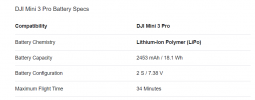New to DJI Mini 3 Pro "smart" battery technology, so coming from another drone brand, I used to maintain LiPos by storing at 50% and not left at full charge for more than a few days.
Q1: If I have a fully charged battery will it discharge itself down to "storage" voltage if left for x days?
Q2: On the LED display, is two green lights showing a storage voltage or should it go down to one?
Q3: Should I "fly down" the battery to 50% or all the way for best battery life?
Thanks in advance......
Q1: If I have a fully charged battery will it discharge itself down to "storage" voltage if left for x days?
Q2: On the LED display, is two green lights showing a storage voltage or should it go down to one?
Q3: Should I "fly down" the battery to 50% or all the way for best battery life?
Thanks in advance......












